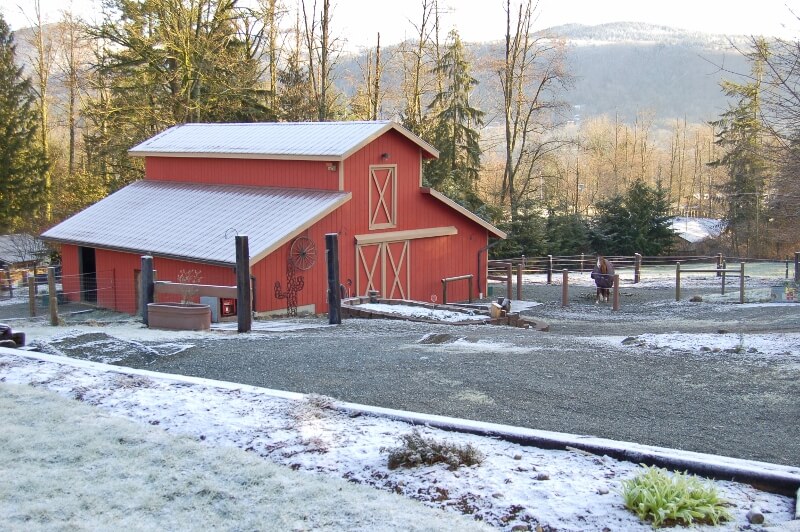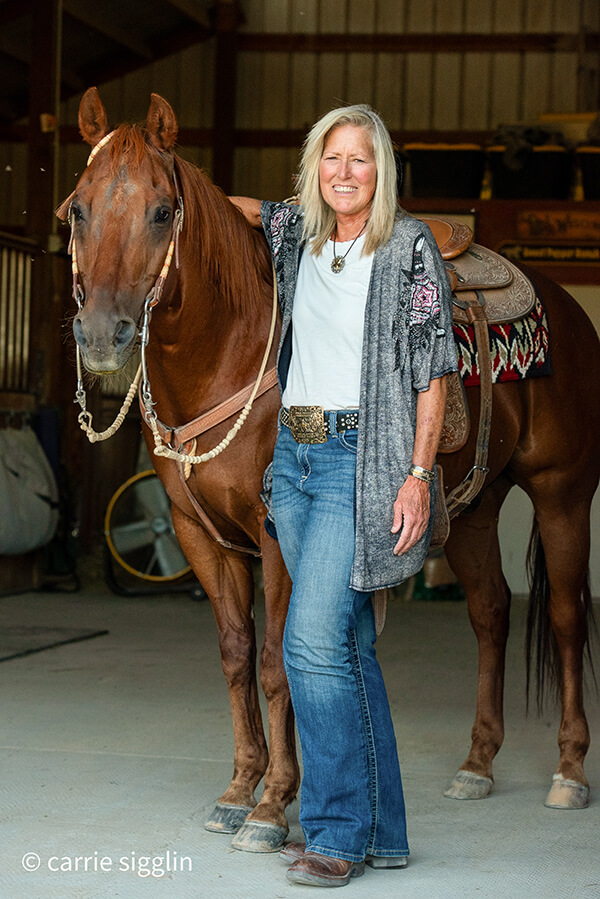Increase Chore Efficiency for an Easier Winter
by Alayne Blickle, Horses for Clean Water

Making chore efficiency updates on your horse property and having backup supplies on-hand is helpful for getting through the most challenging time of the year, and it may help you avoid disasters when winter storms hit. The dead of winter and early spring are often times of damaging, dangerous storms for the Pacific Northwest. Plan and be prepared using this list.
Review lighting needs. Most of the time in winter we horse owners feed in the dark and come home in the dark. Having some kind of indoor and outdoor lighting systems will help immensely with chore efficiency.
When you’re feeding at night in the dead of winter do you have enough light to weigh hay or see if it’s mold-free and green? Cleaning paddocks and staying mud-free will be easier to make happen if there’s outdoor lighting and you can see the manure. Solar lighting along walkways or drives makes nighttime travels safer. Prepare now instead of waiting until temperatures are freezing and you’re trying to feed by flashlight.
Consider your equipment needs. Do you have a headlamp that frees up your hands? Put one in an easily accessed location in the house and in the barn. Are extra batteries on hand? How about fuel for generators, cook stoves, and lanterns? Having a car cell phone charger on hand is extremely important to power cell phones. A cell phone with a dead battery is no help.
Set up a water supply that won’t freeze or get icy cold during winter weather events. A horse drinks 8 to 12 gallons of water per day, preferring water temperatures of about 45-65 degrees. Horses drink less when water is icy cold, and research shows they cannot get enough moisture by eating snow. Inadequate water consumption can lead to colic, so make sure your horses are drinking.
On very cold days you can either break ice twice daily or consider getting a stock tank heater or heated stall or muck buckets.
Develop a backup plan for watering your horses if you are concerned that you might lose power to your private well. Water can be stored in rain barrels or garbage cans. Emergency officials generally recommend having a 3-day supply of water on hand, which is a minimum of 30 gallons of water per horse.
Check waterproof horse blankets for rips or other needed mending or washing so they are ready for use should you need them.
Consider your own wintertime, water-proof clothing needs. This is a fundamental yet often overlooked point. As a horse owner, you are likely to be working with horses in inclement weather for an undetermined amount of time.
Invest in a quality waterproof jacket, knee-high mud boots, and insulated waterproof gloves. These items will go a long way to staying ahead on winter chores as well as helping you out if there’s a winter emergency. You are no good to your horses if you become hypothermic and become a medical emergency yourself.
Floodproof your property. If you live in a flood prone area or near a creek, river, or wetlands, it’s good to review the high-water locations on your property. If it’s difficult to visualize these, get help from your county or your local conservation district. Acquaint yourself with the historic high-water locations recorded for your property.
If you live in an extremely flood prone area (of which there are many in Western Washington), it may be wise to consider building a “critter pad” — a large mound or small hill built above the flood level to keep the animals out of water. Critter pads usually require special permitting and must be specifically engineered using approved fill material to ensure they stand up to high traffic use, heavy rains and high-water volumes – and remain above flood levels.
In some cases, there may be funding or technical assistance available to help with the development of a critter pad, contact your local conservation district, Natural Resources Conservation Service (NRCS) office or Federal Emergency Management Agency (FEMA) office for more assistance.
Find more good resource tips and ideas on winter preparedness are at: www.takewinterbystorm.org

Alayne Blickle began in the 1990’s as a pioneer in water conservation and natural resources conservation by creating the entrepreneurial consulting business, Horses for Clean Water, an award-winning internationally acclaimed education program that looks for horse-healthy, nature-based solutions to land management challenges. She continues this work today partnering with agencies, organizations, and horse owners throughout North America and worldwide. She is a regularly contributing writer and photojournalist to several equine publications.
Alayne lives with her horse trainer husband, Matt Livengood, in southwestern Idaho where they raise and train AQHA horses and mustangs on their eco-friendly horse ranch. Contact her through the Horses for Clean Water website or through their ranch website Sweet Pepper Ranch.
For more information contact Alayne at [email protected] or 206-909-0225.





